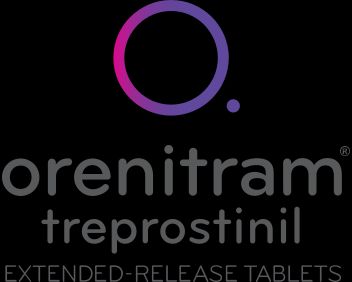Orenitram® (treprostinil)
We’re behind you all the way.
Questions are a natural part of starting a new treatment. It’s our job to point you to answers and resources when and where you need them. Your Patient Navigator will meet with you early in your treatment journey—and as often as it’s helpful—to guide you through how we can assist you best.


Step 1: Education & Expectations
Getting started with your Patient Navigator.
From the get-go, your Patient Navigator will provide education on our program offerings and tailoring ongoing communications according to your needs and schedule. Any questions you run into regarding our support or the safe and effective use of your treatment, they’ll be there to help answer them.
Step 2: Insurance & Coverage
Expertise for all things insurance.
We’ve made a point of ensuring your United Therapeutics Cares™ team knows the insurance landscape inside and out. United Therapeutics Cares will walk you through the specifics of your plan and work with your care team to help navigate coverage for your therapy.
Understanding your plan
Not sure where to start with insurance? We get it. At its simplest, insurance is typically split into commercial (or private) plans and government plans, which include Medicare and Medicaid.
Private healthcare coverage that is typically offered through an employer, purchased through the Health Insurance Marketplace, or obtained directly from an insurance carrier or broker.
Healthcare coverage that is supplied directly by the government. These plans include Medicare, Medicaid, Veterans Health Administration, the Children’s Health Insurance Program (CHIP), TRICARE, and Indian Health Services.
Understanding your plan
Not sure where to start with insurance? We get it. At its simplest, insurance is typically split into commercial (or private) plans and government plans, which include Medicare and Medicaid.
Private healthcare coverage that is typically offered through an employer, purchased through the Health Insurance Marketplace, or obtained directly from an insurance carrier or broker.
Healthcare coverage that is supplied directly by the government. These plans include Medicare, Medicaid, Veterans Health Administration, the Children’s Health Insurance Program (CHIP), TRICARE, and Indian Health Services.
Navigating your coverage
Insurance details can be tricky to grasp. We’re here to help fill in any gaps in your understanding. Your Patient Navigator can connect you to an Access & Affordability Specialist who will walk you through your plan, what your coverage includes, and provide education on financial assistance options if your treatment isn’t covered.
Navigating your coverage
Insurance details can be tricky to grasp. We’re here to help fill in any gaps in your understanding. Your Patient Navigator can connect you to an Access & Affordability Specialist who will walk you through your plan, what your coverage includes, and provide education on financial assistance options if your treatment isn’t covered.
Benefits investigation
Behind the scenes, we’ll verify the coverage your insurance plan provides for your prescribed medication. If needed, we will also identify the steps required for prior authorizations and coordinate prescription logistics with your Specialty Pharmacy.
Benefits investigation
Behind the scenes, we’ll verify the coverage your insurance plan provides for your prescribed medication. If needed, we will also identify the steps required for prior authorizations and coordinate prescription logistics with your Specialty Pharmacy.
Step 3: Cost & Savings
Accessible treatment starts with affording it.
Insurance may not cover all of your out-of-pocket prescription costs. Your Patient Navigator can share with you a number of additional potential cost-saving options that may be able to make your treatment more affordable depending on your eligibility.
Co-pay assistance
If you have a commercial insurance plan, our co-pay assistance program can help cover your out-of-pocket expenses. If you’re eligible, you may qualify to pay as little as a $0 co-pay per month for Orenitram. The United Therapeutics Cares Co-Pay Assistance Program will pay the difference up to a monthly maximum program benefit.*
Terms & Conditions *Patients must meet certain eligibility criteria to qualify for assistance. Patients receiving reimbursement under Medicare, Medicaid, VA, DoD (TRICARE), Indian Health Services, or similar federal or state programs, may not be eligible for some assistance. Some portion of this patient assistance may be administered by third-party patient assistance organizations. The Program is subject to additional state law restrictions. Patients residing in select states may not be eligible for the Program.Co-pay assistance
If you have a commercial insurance plan, our co-pay assistance program can help cover your out-of-pocket expenses. If you’re eligible, you may qualify to pay as little as a $0 co-pay per month for Orenitram. The United Therapeutics Cares Co-Pay Assistance Program will pay the difference up to a monthly maximum program benefit.*
Terms & Conditions *Patients must meet certain eligibility criteria to qualify for assistance. Patients receiving reimbursement under Medicare, Medicaid, VA, DoD (TRICARE), Indian Health Services, or similar federal or state programs, may not be eligible for some assistance. Some portion of this patient assistance may be administered by third-party patient assistance organizations. The Program is subject to additional state law restrictions. Patients residing in select states may not be eligible for the Program.Patient Assistance Program
If you are currently uninsured or underinsured, you may meet the eligibility requirements for our Patient Assistance Program (PAP). Reach out to United Therapeutics Cares to learn more about eligibility and if you qualify.
Patient Assistance Program
If you are currently uninsured or underinsured, you may meet the eligibility requirements for our Patient Assistance Program (PAP). Reach out to United Therapeutics Cares to learn more about eligibility and if you qualify.
Additional financial resources
Search community-based and national organizations offering support and resources that may be available to assist you depending on your eligibility.
To explore additional third-party financial options visit
info.reassist.comAdditional financial resources
Search community-based and national organizations offering support and resources that may be available to assist you depending on your eligibility.
To explore additional third-party financial options visit
info.reassist.com
Step 4: Prescription Coordination
Coordinating with your Specialty Pharmacy.
Our goal is to support you during your United Therapeutics treatment. Your prescription and refills are a big part of that. Your Patient Navigator will help you get set up with your Specialty Pharmacy. Your Specialty Pharmacy will work directly with you to fill your prescription and coordinate your delivery at a time and place that works best for you.
This is how Specialty Pharmacies work:
- Your Specialty Pharmacy will conduct a review of your insurance benefits.
- Your Specialty Pharmacy will confirm your medication coverage.
- Your Specialty Pharmacy will call to review your co-payment and insurance coverage.
- Shipments will be scheduled for delivery where it’s most convenient for you.
Our Orenitram® Specialty Pharmacy network
Step 5: Treatment Support
Experience by your side.
Our support doesn’t end when your coverage is approved and your prescription is filled. Let us know your communication preferences, and your Patient Navigator will check in accordingly to answer questions and make sure you have the support you need.

Even more support
Our Patient Education Specialists are available to work with you one-on-one to help you understand your condition and answer questions about your United Therapeutics therapy.
Get to know them
Your connection to community
Find links to additional educational resources and to third-party organizations that get what you’re going through and have insights that may be able to help.
Learn moreResources
Anytime access to information.
You deserve ready access to education and support. That’s why we offer a suite of treatment specific brochures to offer answers and education anytime you need it.
See all resources
Enrollment in United Therapeutics Cares™ is step one.
Get startedAlready enrolled? Get in touch with your team
Please see below for Important Safety Information
Who should not take Orenitram?
Do not take Orenitram if you have severe liver problems.
What should I tell my healthcare provider before taking Orenitram?
Tell your healthcare provider:
- If you have liver problems or diverticulosis.
- If you are pregnant, breastfeeding, and/or plan to become pregnant or breastfeed. It is not known if Orenitram will harm your unborn baby or if Orenitram passes into your breast milk. Talk to your healthcare provider about the best way to feed your baby during treatment with Orenitram.
IMPORTANT SAFETY INFORMATION FOR ORENITRAM
Who should not take Orenitram?
Do not take Orenitram if you have severe liver problems.
What should I tell my healthcare provider before taking Orenitram?
Tell your healthcare provider:
- If you have liver problems or diverticulosis.
- If you are pregnant, breastfeeding, and/or plan to become pregnant or breastfeed. It is not known if Orenitram will harm your unborn baby or if Orenitram passes into your breast milk. Talk to your healthcare provider about the best way to feed your baby during treatment with Orenitram.
- About all the medicines you take, including prescription and over-the-counter medicines, vitamins, and herbal supplements. Orenitram and other medicines may affect each other causing side effects. Do not start any new medicine until you check with your healthcare provider. Especially tell your healthcare provider if you take another medicine that contains treprostinil, such as Remodulin® or Tyvaso®.
How should I take Orenitram?
- Do not change your dose or suddenly stop taking Orenitram without first talking to your healthcare provider.
- Orenitram is usually taken 3 times a day (about every 8 hours) or 2 times a day (about every 12 hours). Your healthcare provider will tell you how often you should take Orenitram. If you have side effects, your healthcare provider may tell you to change your dose or when you take Orenitram. Take Orenitram with food.
- Swallow Orenitram tablets whole. Do not split, chew, crush, or break your Orenitram tablets. Do not take Orenitram tablets that are damaged or broken. If Orenitram tablets are not taken whole, they may release too much medicine at one time. This can lead to side effects.
- If you miss your dose of Orenitram, take the missed dose as soon as possible with food.
- If you miss 2 or more doses of Orenitram, call your healthcare provider to see if you need to change your dose.
- If you take too much Orenitram, call your healthcare provider or go to the nearest hospital emergency room right away.
- You may see the tablet shell in your stools (bowel movements). This is usually normal. The tablet shell is not digested. If you have diverticulosis, the tablet shell may get stuck in a blind pouch or diverticulum in your intestine.
What are the possible side effects of Orenitram?
Orenitram can cause serious side effects, including worsening of PAH symptoms.
- Stopping Orenitram suddenly may cause worsening of your PAH symptoms. Do not change your dose or suddenly stop taking Orenitram without first talking to your healthcare provider.
- The most common side effects of Orenitram include headache, diarrhea, nausea, vomiting, flushing, and pain in arms, legs, and jaw. These are not all of the possible side effects of Orenitram. Tell your healthcare provider if you have any side effect that bothers you or does not go away.
- Call your healthcare provider for medical advice about side effects. You may report side effects to the FDA at www.fda.gov/MedWatch or call 1-800-FDA-1088.
The risk information provided here is not comprehensive. To learn more about Orenitram, talk with your healthcare provider. Please see Full Prescribing Information and Patient Information at www.orenitram.com or call Customer Service at 1-877-UNITHER (1-877-864-8437).
OREISIconOCT19

